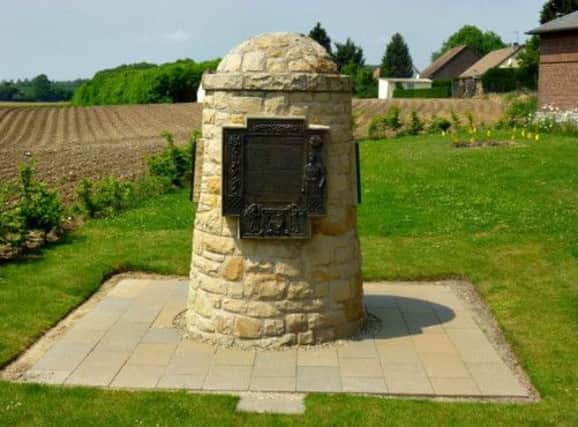Lost Edinburgh: McCrae’s Battalion
This article contains affiliate links. We may earn a small commission on items purchased through this article, but that does not affect our editorial judgement.


Yesterday, at 11am, a large crowd including players and supporters of Heart of Midlothian Football Club gathered for Remembrance Day at the Haymarket war memorial. At this particular remembrance service, it is for the courageous men who fought as part of the 16th Royal Scots – McCrae’s Battalion, that the admiration is most pronounced.
The outbreak of war
Following Great Britain’s declaration of war on Germany in August 1914, a frantic scramble for willing recruits gripped the nation. Such was the intense support for war against the Kaiser, that those who were less enthusiastic to fight were accused of cowardice and often faced public condemnation. A debate began to rage over why popular sports such as football, played by physically fit and able-bodied men, should be allowed to continue.
Advertisement
Hide AdAdvertisement
Hide AdIn Scotland, the bulk of this wrath was reserved for the top team in the country, and as fate would have it, in 1914 that team was Heart of Midlothian.
Hearts had made the most emphatic start to a season in their short history by winning their first eight league fixtures. This early success came at a price as Hearts’ players began to attract criticism for continuing the ‘awful farce of football’ while their fellow countrymen perished overseas. A letter from the pen of ‘A Soldier’s Daughter’ published by the Edinburgh Evening News suggested that, unless they were prepared to fight, the club should adopt a new name: ‘The White Feathers of Midlothian’.
McCrae’s Own
In November 1914 the well-respected local businessman and former MP Sir George McCrae launched an appeal to the young men of Edinburgh to join his own battalion for active duty in the field. McCrae’s ambitious aim to source a full unit within just 7 days sounded fanciful, but his confidence was justified as thirteen professional players contracted to Heart of Midlothian answered his call. They were the first football club in Britain to do so.
Hearts’ brave leap into the unknown had an immediate knock-on effect, as within days hundreds of the club’s supporters began to follow in their heroes footsteps. McCrae’s Battalion quickly managed to attract a full complement of 1,350 recruits - including a great number of football players and supporters of rival clubs such as Hibernian, Raith Rovers, Falkirk and Dunfermline. The example set by the Hearts players had proved pivotal. McCrae’s Own - the original sportsmen’s battalion was born.
Disappointingly for the men in maroon, the 1914/15 league title would head westwards to a Celtic side free from the rigours of military training. Missing out on silverware, however, would pale in comparison to Hearts’ true sacrifice just one year later.
The supreme sacrifice
The casualties on the first day of the Battle of the Somme on July 1st 1916 rank among the most catastrophic in British military history. Soldiers were mown down relentlessly as they toiled to advance towards the heavily fortified German trenches. The following morning, the bodies of 20,000 British soldiers lay strewn across the bloodied battlefields with a further 40,000 badly wounded.
McCrae’s Own suffered massive losses as they battled bravely to try and capture the ruined village of Contalmaison. With over three quarters of its attacking power depleted, the fact that the battalion had delved deeper into enemy territory than any other that day would have provided McCrae with scant consolation. Hearts players Harry Wattie, Duncan Currie, Ernie Ellis, Jimmy Speedie, Jimmy Body, Tom Gracie and John Allan all perished during the Great War. Paddy Crossan and Robert Mercer eventually suffered from the effects of wartime gassing, while Alfie Briggs was crippled in action and never played again.
Commemoration
Advertisement
Hide AdAdvertisement
Hide AdIn 1922, a memorial was erected at Haymarket by Hearts Football Club in honour of their players and supporters who had fallen in the Great War. At the unveiling ceremony, a 35,000-strong crowd listened to the Secretary of State for Scotland, Robert Munro as he explained how ‘Hearts had shown on the battlefield all the courage, resource, skill, endurance, dash and daring that had made them famous on the football field’. The memorial is still at Haymarket today, having recently returned after a lengthy disappearance due to the tram works.
The fascinating feat of bravery by the Hearts players who went to war has long been a part of Tynecastle folklore, but the finer details of Lieutenant-Colonel Sir George McCrae’s Battalion were close to being forgotten. That was until 2003 when author Jack Alexander brought the tale back to public consciousness with his definitive history on the subject. Alexander’s book ‘McCrae’s Battalion – The Story of the 16th Royal Scots’ helped to resurrect interest in the tale and has led to the installation of a permanent memorial to McCrae’s Own on French soil.
McCrae’s Battalion Memorial Cairn at Contalmaison has since become a shrine for avid followers of the Scottish game. A plaque outside Tynecastle, unveiled in September of this year, confirms the intention to ensure that this piece of Edinburgh history is never lost again.
• David McLean is the founder of the Lost Edinburgh Facebook page. You can follow Lost Edinburgh on Facebook and Twitter.